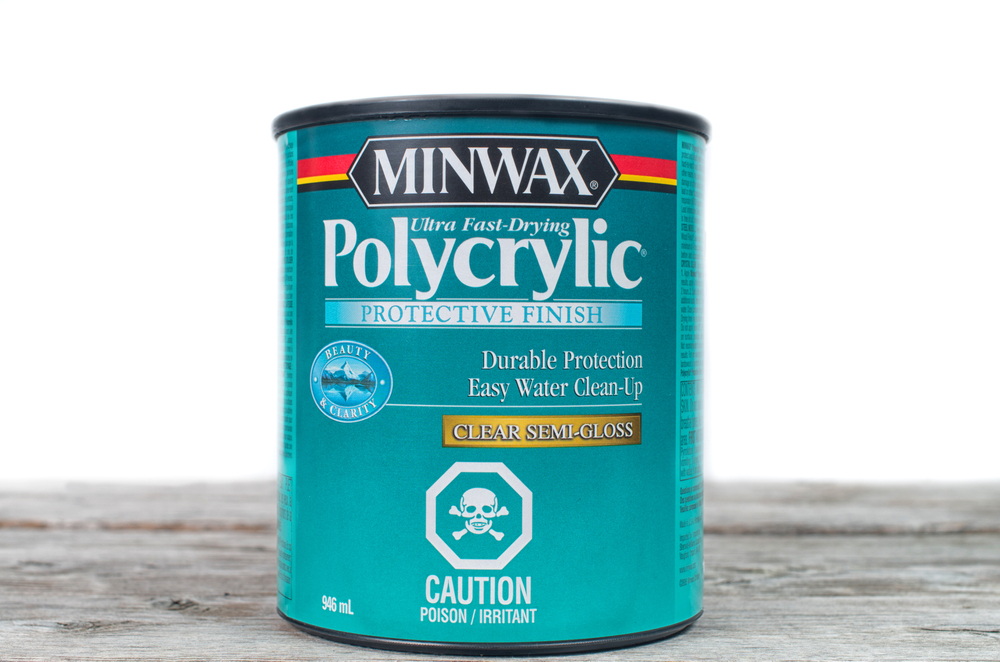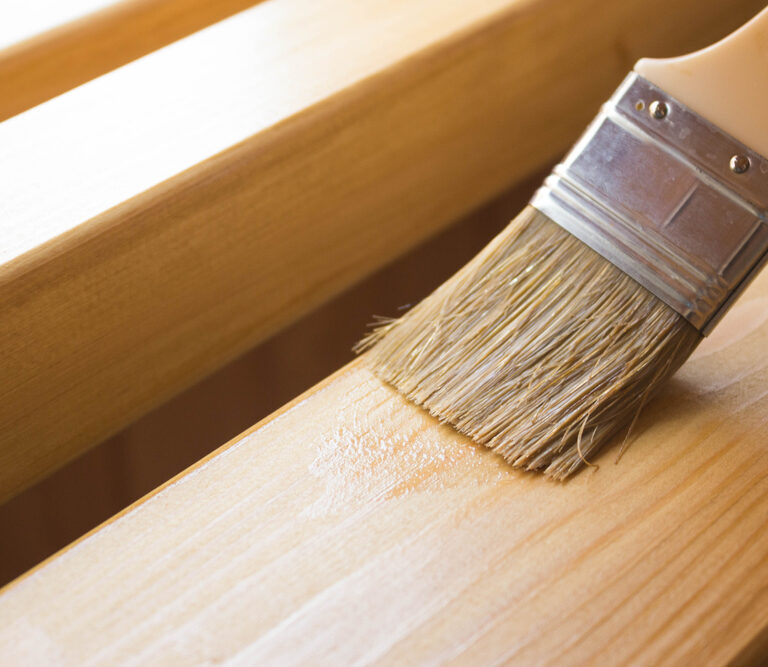Wood is a very versatile material that you can find everywhere, from long-lasting sturdy buildings, to functional furniture, to beautiful works of art. You can fashion it to almost anything, as long as you have the necessary skills. However, it’s also quite fragile and can be easily damaged by moisture, abrasion, and general wear and tear.
Not all of us can make breathtaking furniture out of raw wood — but all of us can take steps to make sure that our wooden furniture lasts as long as possible.
To prevent damages to your wooden treasures, you can use protective coatings and finishes. In this article, we’ll compare polyurethane vs. polycrylic to help you decide which one you should use for your next project.
What Is Polyurethane?
Polyurethane, at its most basic, is a kind of plastic that comes in many different forms.
It can be produced to suit the needs of a wide variety of situations, such as car parts, adhesives, and insulation for freezers and buildings. It’s also used as a surface coating for wood, steel, and concrete.
Polyurethane is very thick and very adherent, which makes it handy for painting vertical surfaces, as it won’t drip down haphazardly. When used to coat wood, it comes in a liquid form that can be applied through a spray or roller.
There are two broad categories of polyurethane: oil-based and water-based.
Oil-Based Polyurethane
If you’re planning to coat wooden furniture that will be staying outdoors or someplace with a lot of moisture, you’re better off using oil-based polyurethane. Not only can it shrug off moisture and resist intense sunlight, but it can also handle high heat easily, unlike its water-based counterpart.
The main problem with oil-based polyurethanes is that they contain a lot more “VOCs,” or “volatile organic compounds” than water-based varieties. Thus, they tend to emit more fumes, which are highly flammable and toxic to your health. You should take the proper precautions when dealing with them and use the correct safety gear, like gloves and masks.
Oil-based polyurethanes also takes a long time to dry. It can take around 24 hours to become dry to the touch, and will take at least a month to cure properly.
Water-Based Polyurethane
Water-based polyurethanes can resist moisture and extreme temperatures to some degree, but not as well as oil-based ones.
That said, the main advantage of water-based polyurethane is that it’s less toxic than its oil-based counterpart. It contains as much as 50% fewer VOCs, making it more friendly to your nose and lungs.
This kind of polyurethane dries relatively fast in just 6 hours, resulting in a shorter waiting time upon application. However, it still takes quite some time to fully cure —up to a month in some instances.
Take note that although those are the main differences, there is a wide variety of polyurethane finishes available on the market. For example, you can buy matte, satin, semi-gloss, and high-gloss polyurethane sheens. You can also find polyurethane that’s specifically made for certain purposes, such as for flooring or for outdoor use.
Benefits of Using Polyurethane
Polyurethane is a tried and trusted partner when it comes to wood finishing. Here are some of the common reasons why you might prefer polyurethane to polycrylic.
Appearance
For those who are after the appearance, oil-based polyurethane provides an additional charm due to its distinct yellowish tint when it dries.
With the right wood, polyurethane coating can easily enhance the warm tones while also protecting it at the same time. This trait makes polyurethane ideal for the right hardwood flooring, as it helps the floor lasts longer, protects it against foot traffic, and gives it a unique tint over time.
If your furniture is made from light wood, like maple or birch, and you don’t want it to look yellow, however, you should opt for water-based polyurethane instead, since it dries clear.
Ease of Application
Because polyurethane is thick and sticks easily to the surface, it’s very easy to apply to wood, even on curved or vertical surfaces. Moreover, you can use either a spray or a brush to coat the surface, which makes it easier to control the amount that gets transferred, unlike with polycrylic.
Superior Durability
Polyurethane can resist a wide variety of conditions, from extreme temperatures to moisture, to scratch and abrasions. This makes it ideal to use on furniture pieces that face a lot of day-to-day wear and tear, such as tables, chairs, or other outdoor furniture that is always exposed to the elements.
What Is Polycrylic?

Polycrylic is a specific brand of wood finish that is manufactured by MinWax, a company specializing in wood treatment. It was made to improve on polyurethane’s negative properties.
It’s generally cheaper than polyurethane, contains fewer VOCs, and is less odorous and toxic It’s also more environmentally friendly, and, being water-based, it can be easily washed away with soap. This makes for an easier time when cleaning up messes or spills.
Just like polyurethane, polycrylic can also be applied using a brush or a spray. It dries to the touch in about 30 minutes, much quicker than polyurethane. Even curing is much quicker, and usually takes about 24 hours or more, depending on the manufacturer.
Appearance-wise, polycrylic provides a clear coating that is also sold in a variety of shines, such as matte, satin, semi-gloss, and high-gloss.
In terms of durability, however, polycrylic doesn’t stand up to heat as much as polyurethane does. It also doesn’t have as much resistance to wear and abrasions, which makes it more susceptible to scuffles when subjected to regular, everyday traffic. Due to this, polycrylic is best for indoor display furniture.
Benefits of Using Polycrylic
Although it’s been around for a shorter time than polyurethane, polycrylic has also become a popular choice in preserving the beauty and integrity of wood. Here are some reasons why you might want to choose it over polyurethane.
Environmentally Friendly
Polycrylic is water-based, which means that it is water-soluble. You can easily dispose of extra polycrylic by pouring it into the sink if you wish, unlike the more toxic polyurethane that is most likely covered by specific regulations. In case you get spills or drips, you can also simply wash away polycrylic with soap and water, so it’s a much safer choice for indoor application.
Safer for Your Health
Polycrylic contains far fewer VOCs than polyurethane, even the water-based kind. This means three things. One, it gives off fewer fumes, so it’s less likely to endanger your health. Two, it’s not as flammable, which makes it safer to use indoors. And three, there’s less need for safety gear like face masks and gloves when working with polycrylic.
Shorter Drying Time
Polycrylic dries much faster than polyurethane, taking only about 30 minutes to become dry to the touch, and 24 hours to fully cure. This makes for less waiting time between applications, which is ideal when you’re painting an interior piece and you don’t want to leave it outside too long to wait for it to dry.
Choosing Between Polycrylic vs. Polyurethane
As you can see, both products have excellent characteristics that keep wood safe and looking lovely.
So, how should you decide what to use? The answer is: it depends. Here are a few guidelines on when to use polycrylic or when to use polyurethane.
When to Use Polycrylic
If You’re on a Budget
Since polyurethane is generally more expensive than polycrylic, you should choose polycrylic if you only need small touch-ups on your furniture or if you’re doing DIY projects on a budget.
If You Need to Ensure Easy Cleanup
Polycrylic is your best bet if you’re working on the interior of your home. You can easily wash it with soap and water in case of mistakes, especially if you clean it before it fully dries.
If You’re Working Indoors
Due to its high VOC content, using polyurethane indoors can create problems, especially if there’s no proper ventilation in the area. Polycrylic has minimal VOC content, making it more ideal for indoor work.
If You Have Limited Time
Polycrylic dries to the touch in only 30 minutes or so, and will fully cure in about 24 hours. If you’re rushing a project this weekend, or if you’re simply pressed for time, go for polycrylic.
If the Wood Calls for It
If you’re using light-colored wood like maple and want to preserve its natural color, opt for polycrylic. It’s perfectly transparent and will provide little to no yellowing in the final product.
When to Use Polyurethane
If You’re Willing to Spend More
Polyurethane is a little more expensive than polycrylic, but it makes up for it by its many advantages.
If You’re Painting on a Curve or a Vertical Surface
Polyurethane is thicker than polycrylic, and wouldn’t drip or create much mess during application.
If Your Project Is Outdoors
If you’re planning to coat furniture on your gazebo or front porch, then the sturdiness and durability of polyurethane is your best friend. It can stand up to the elements better, doesn’t get easily scratched or abraded, and resists moisture fairly well.
If You’re Coating Your Floors
Similarly, finishing for flooring is also best-done using polyurethane. This is because polyurethane is highly resistant to daily wear and tear, and thus can tolerate more traffic than polycrylic.
Final Thoughts
We hope that our helpful guide has given you the advice and guidance you need to make an informed decision between using polycrylic and polyurethane on your wood surfaces. Whatever it is that you choose, hopefully, it can keep your wood pieces protected for a long time to come.
